Experimental and Numerical Assessment of Seismic Retrofit Solutions for Stone Masonry Buildings
Abstract
1. Introduction
- improvement of connections;
- stiffening of floor diaphragms;
- enhancement of masonry properties.
2. Experimental Program
2.1. Masonry Structures
2.2. Timber Floor and Roof Structures
2.3. Retrofit of First-Floor Diaphragms and Connections
2.4. Retrofit of Roof Diaphragms and Connections
2.5. Material Properties and Masses
2.6. Testing Protocol and Results
3. Numerical Simulations
3.1. Modeling Strategy
3.2. Calibration of Masonry Material Properties
3.3. Calibration of Membrane and Beam Element Stiffness
- is oriented parallel to the timber joists, orthogonal to the shaking direction;
- is oriented parallel to the original timber planks and to the shaking direction;
- is the thickness assigned to the model membrane;
- is the Young modulus of timber for the joists;
- and are the cross-section area and the spacing of the timber joists;
- and are the Young and shear moduli of timber for the existing planks;
- , , and are the thickness, cross-section area, and moment of inertia of each existing timber planks;
- is the Young modulus of timber for the additional planks;
- and are the thickness of the additional timber planks or panels and their orientation with respect to the existing planks;
- is the Young modulus of timber for the additional panels;
- is the thickness of the additional timber panels;
- and are the Young and shear moduli of concrete;
- is the thickness of the additional reinforced concrete slab;
- is the nailed connection stiffness according to Eurocode 5 [69];
- is the nail spacing at a plank–joist intersection;
- is the shear factor for a rectangular cross-section;
- is a correction coefficient accounting for additional timber layers.
3.4. Comparison between Numerical and Experimental Results
3.5. Paramateric Study on Masonry Mechanical Improvements
4. Summary and Conclusions
Author Contributions
Funding
Data Availability Statement
Acknowledgments
Conflicts of Interest
References
- D’Ayala, D.; Paganoni, S. Assessment and analysis of damage in L’Aquila historic city centre after the 6th April 2009. Bull. Earthq. Eng. 2011, 9, 81–104. [Google Scholar] [CrossRef]
- Carocci, C.F. Small centres damaged by 2009 L’Aquila earthquake: On site analyses of historical masonry aggregates. Bull. Earthq. Eng. 2012, 10, 45–71. [Google Scholar] [CrossRef]
- Da Porto, F.; Silva, B.; Costa, C.; Modena, C. Macro-Scale Analysis of Damage to Churches after Earthquake in Abruzzo (Italy) on April 6, 2009. J. Earthq. Eng. 2012, 16, 739–758. [Google Scholar] [CrossRef]
- Lagomarsino, S. Damage assessment of churches after L’Aquila earthquake (2009). Bull. Earthq. Eng. 2011, 10, 73–92. [Google Scholar] [CrossRef]
- Penna, A.; Calderini, C.; Sorrentino, L.; Carocci, C.F.; Cescatti, E.; Sisti, R.; Borri, A.; Modena, C.; Prota, A. Damage to churches in the 2016 central Italy earthquakes. Bull. Earthq. Eng. 2019, 17, 5763–5790. [Google Scholar] [CrossRef]
- Sorrentino, L.; Cattari, S.; da Porto, F.; Magenes, G.; Penna, A. Seismic behaviour of ordinary masonry buildings during the 2016 central Italy earthquakes. Bull. Earthq. Eng. 2019, 17, 5583–5607. [Google Scholar] [CrossRef]
- Tomaževič, M.; Weiss, P.; Velechovsky, T. The influence of rigidity of floors on the seismic behaviour of old stone-masonry buildings. Eur. Earthq. Eng. 1991, 3, 28–41. [Google Scholar]
- Benedetti, D.; Carydis, P.; Pezzoli, P. Shaking table test on 24 masonry buildings. Earthq. Eng. Struct. Dyn. 1998, 27, 67–90. [Google Scholar] [CrossRef]
- Rota, M.; Penna, A.; Strobbia, C.; Magenes, G. Typological Seismic Risk Maps for Italy. Earthq. Spectra 2011, 27, 907–926. [Google Scholar] [CrossRef]
- Costa, A.A.; Arede, A.; Costa, A.; Penna, A.; Costa, A. Out-of-plane behaviour of a full-scale stone masonry façade. Part 1: Specimen and ground motion selection. Earthq. Eng. Struct. Dyn. 2013, 42, 2081–2095. [Google Scholar] [CrossRef]
- Costa, A.A.; Arêde, A.; Costa, A.C.; Penna, A.; Costa, A. Out-of-plane behaviour of a full scale stone masonry façade. Part 2: Shaking table tests. Earthq. Eng. Struct. Dyn. 2013, 42, 2097–2111. [Google Scholar] [CrossRef]
- Senaldi, I.E.; Guerrini, G.; Comini, P.; Graziotti, F.; Penna, A.; Beyer, K.; Magenes, G. Experimental seismic performance of a half-scale stone masonry building aggregate. Bull. Earthq. Eng. 2019, 18, 609–643. [Google Scholar] [CrossRef]
- Tolles, E.L.; Webster, F.A.; Crosby, A.; Kimbro, E.E. Survey of Damage to Historic Adobe Buildings after the January 1994 Northridge Earthquake; The Getty Conservation Institute: Los Angeles, CA, USA, 1996. [Google Scholar]
- Vintzileou, E.; Mouzakis, C.; Adami, C.-E.; Karapitta, L. Seismic behavior of three-leaf stone masonry buildings before and after interventions: Shaking table tests on a two-storey masonry model. Bull. Earthq. Eng. 2015, 13, 3107–3133. [Google Scholar] [CrossRef]
- Mouzakis, C.; Adami, C.-E.; Karapitta, L.; Vintzileou, E. Seismic behaviour of timber-laced stone masonry buildings before and after interventions: Shaking table tests on a two-storey masonry model. Bull. Earthq. Eng. 2017, 16, 803–829. [Google Scholar] [CrossRef]
- Decanini, L.; de Sortis, C.A.; Goretti, A.; Langenbach, R.; Mollaioli, F.; Rasulo, A. Performance of Masonry Buildings during the 2002 Molise, Italy, Earthquake. Earthq. Spectra 2004, 20 (Suppl. 1), 191–220. [Google Scholar] [CrossRef]
- Binda, L.; Cardani, G.; Saisi, A. A classification of structures and masonries for the adequate choice of repair. In Proceedings of the International RILEM Workshop on Repair Mortars for Historic Masonry, Delft, The Netherlands, 26–28 January 2005. [Google Scholar]
- Valluzzi, M.R. On the vulnerability of historical masonry structures: Analysis and mitigation. Mater. Struct. 2006, 40, 723–743. [Google Scholar] [CrossRef]
- Modena, C.; Valluzzi, M.R.; da Porto, F.; Casarin, F. Structural Aspects of The Conservation of Historic Masonry Constructions in Seismic Areas: Remedial Measures and Emergency Actions. Int. J. Arch. Herit. 2011, 5, 539–558. [Google Scholar] [CrossRef]
- Sisti, R.; Di Ludovico, M.; Borri, A.; Prota, A. Damage assessment and the effectiveness of prevention: The response of ordinary unreinforced masonry buildings in Norcia during the Central Italy 2016–2017 seismic sequence. Bull. Earthq. Eng. 2019, 17, 5609–5629. [Google Scholar] [CrossRef]
- Karantoni, F.V.; Fardis, M. Effectiveness of Seismic Strengthening Techniques for Masonry Buildings. J. Struct. Eng. 1992, 118, 1884–1902. [Google Scholar] [CrossRef]
- Frumento, S.; Giovinazzi, S.; Lagomarsino, S.; Podestà, S. Seismic retrofitting of unreinforced masonry buildings in Italy. In Proceedings of the New Zealand Society for Earthquake Engineering Conference, Napier, New Zealand, 10–12 March 2006. [Google Scholar]
- Modena, C.; Valluzzi, M.R.; Garbin, E.; da Porto, F. A strengthening technique for timber floors using traditional materials. In Proceedings of the 4th Structural Analysis of Historical Constructions Conference, Padova, Italy, 10–12 November 2004. [Google Scholar]
- Moreira, S.M.T.; Ramos, L.F.; Oliveira, D.V.; Lourenco, P. Experimental behavior of masonry wall-to-timber elements connections strengthened with injection anchors. Eng. Struct. 2014, 81, 98–109. [Google Scholar] [CrossRef]
- Moreira, S.; Ramos, L.F.; Oliveira, D.V.; Lourenco, P. Design Parameters for Seismically Retrofitted Masonry-To-Timber Connections: Injection Anchors. Int. J. Arch. Herit. 2015, 10, 217–234. [Google Scholar] [CrossRef]
- Guerrini, G.; Senaldi, I.; Graziotti, F.; Magenes, G.; Beyer, K.; Penna, A. Shake-Table Test of a Strengthened Stone Masonry Building Aggregate with Flexible Diaphragms. Int. J. Arch. Herit. 2019, 13, 1078–1097. [Google Scholar] [CrossRef]
- Tomaževič, M.; Lutman, M.; Weiss, P. Seismic Upgrading of Old Brick-Masonry Urban Houses: Tying of Walls with Steel Ties. Earthq. Spectra 1996, 12, 599–622. [Google Scholar] [CrossRef]
- Celik, O.; Sesigur, H.; Cili, F. Importance of wood and iron tension members on seismic performance of historic masonry buildings: Three case studies from Turkey. In Proceedings of the ATC and SEI Conference on Improving the Seismic Performance of Existing Buildings and Other Structures, San Francisco, CA, USA, 9–11 December 2009. [Google Scholar]
- Calderini, C.; Lagomarsino, S.; Rossi, M.; de Canio, G.; Mongelli, M.L.; Roselli, I. Shaking table tests of an arch-pillars system and design of strengthening by the use of tie-rods. Bull. Earthq. Eng. 2014, 13, 279–297. [Google Scholar] [CrossRef]
- Podestà, S.; Scandolo, L. Earthquakes and Tie-Rods: Assessment, Design, and Ductility Issues. Int. J. Arch. Herit. 2019, 13, 329–339. [Google Scholar] [CrossRef]
- Tolles, E.L.; Kimbro, E.E.; Webster, F.A.; Ginell, W.S. Seismic Stabilization of Historic Adobe Structures. Final Report of the Getty Seismic Adobe Project; The Getty Conservation Institute: Los Angeles, CA, USA, 2000. [Google Scholar]
- Sikka, S.; Chaudhry, C. Research on the Upgrade of Traditional Seismic Retrofits for Ancient Buddhist Temples in the Region of Spiti and Kinnaur in the Western Himalayas. In Proceedings of the Getty Seismic Adobe Project 2006 Colloquium, Los Angeles, CA, USA, 11–13 April 2006; Hardy, M., Cancino, C., Ostergren, G., Eds.; The Getty Conservation Institute: Los Angeles, CA, USA, 2009. [Google Scholar]
- Borri, A.; Castori, G.; Grazini, A. Retrofitting of masonry building with reinforced masonry ring-beam. Constr. Build. Mater. 2009, 23, 1892–1901. [Google Scholar] [CrossRef]
- Guadagnuolo, M.; Faella, G. Simplified Design of Masonry Ring-Beams Reinforced by Flax Fibers for Existing Buildings Retrofitting. Buildings 2020, 10, 12. [Google Scholar] [CrossRef]
- Piazza, M.; Baldessari, C.; Tomasi, R. The role of in-plane floor stiffness in the seismic behaviour of traditional buildings. In Proceedings of the 14th World Conference on Earthquake Engineering, Beijing, China, 12–17 October 2008. [Google Scholar]
- Valluzzi, M.R.; Garbin, E.; Dalla Benetta, M.; Modena, C. In-plane strengthening of timber floors for the seismic improvement of masonry buildings. In Proceedings of the 11th World Conference on Timber Engineering, Riva del Garda, Italy, 20–24 June 2010. [Google Scholar]
- Nunes, M.; Bento, R.; Lopes, M. In-plane stiffening and strengthening of timber floors for the improvement of seismic behaviour of URM buildings. Int. J. Mason. Res. Innov. 2020, 5, 85. [Google Scholar] [CrossRef]
- Valluzzi, M.R.; Binda, L.; Modena, C. Experimental and analytical studies for the choice of repair techniques applied to historic buildings. Mater. Struct. 2002, 35, 285–292. [Google Scholar] [CrossRef]
- Mazzon, N.; Chavez, C.M.; Valluzzi, M.R.; Casarin, F.; Modena, C. Shaking Table Tests on Multi-Leaf Stone Masonry Structures: Analysis of Stiffness Decay. Adv. Mater. Res. 2010, 133–134, 647–652. [Google Scholar] [CrossRef]
- Vintzileou, E.N.; Toumbakari, E.E. The effect of deep rejointing on the compressive strength of brick masonry. In Historical Constructions; Lourenço, P.B., Roca, P., Eds.; University of Minho: Guimarães, Portugal, 2001; pp. 995–1002. [Google Scholar]
- Corradi, M.; Tedeschi, C.; Binda, L.; Borri, A. Experimental evaluation of shear and compression strength of masonry wall before and after reinforcement: Deep repointing. Constr. Build. Mater. 2008, 22, 463–472. [Google Scholar] [CrossRef]
- Prota, A.; Marcari, G.; Fabbrocino, G.; Manfredi, G.; Aldea, C. Experimental In-Plane Behavior of Tuff Masonry Strengthened with Cementitious Matrix–Grid Composites. J. Compos. Constr. 2006, 10, 223–233. [Google Scholar] [CrossRef]
- Papanicolaou, C.G.; Triantafillou, T.C.; Karlos, K.; Papathanasiou, M. Textile-reinforced mortar (TRM) versus FRP as strengthening material of URM walls: In-plane cyclic loading. Mater. Struct. 2006, 40, 1081–1097. [Google Scholar] [CrossRef]
- Borri, A.; Castori, G.; Corradi, M. Shear behavior of masonry panels strengthened by high strength steel cords. Constr. Build. Mater. 2011, 25, 494–503. [Google Scholar] [CrossRef]
- De Felice, G.; de Santis, S.; Garmendia, L.; Ghiassi, B.; Larrinaga, P.; Lourenco, P.; Oliveira, D.V.; Paolacci, F.; Papanicolaou, C.G. Mortar-based systems for externally bonded strengthening of masonry. Mater. Struct. 2014, 47, 2021–2037. [Google Scholar] [CrossRef]
- Gattesco, N.; Boem, I.; Dudine, A. Diagonal compression tests on masonry walls strengthened with a GFRP mesh reinforced mortar coating. Bull. Earthq. Eng. 2014, 13, 1703–1726. [Google Scholar] [CrossRef]
- Gattesco, N.; Boem, I. Experimental and analytical study to evaluate the effectiveness of an in-plane reinforcement for masonry walls using GFRP meshes. Constr. Build. Mater. 2015, 88, 94–104. [Google Scholar] [CrossRef]
- Carozzi, F.G.; Bellini, A.; D’Antino, T.; de Felice, G.; Focacci, F.; Hojdys, Ł.; Laghi, L.; Lanoye, E.; Micelli, F.; Panizza, M.; et al. Experimental investigation of tensile and bond properties of Carbon-FRCM composites for strengthening masonry elements. Compos. Part B Eng. 2017, 128, 100–119. [Google Scholar] [CrossRef]
- Del Zoppo, M.; di Ludovico, M.; Prota, A. Analysis of FRCM and CRM parameters for the in-plane shear strengthening of different URM types. Compos. Part B Eng. 2019, 171, 20–33. [Google Scholar] [CrossRef]
- Türkmen, Ö.S.; de Vries, B.T.; Wijte, S.N.M.; Vermeltfoort, A.T. In-plane behaviour of clay brick masonry wallettes retrofitted with single-sided fabric-reinforced cementitious matrix and deep mounted carbon fibre strips. Bull. Earthq. Eng. 2020, 18, 725–765. [Google Scholar] [CrossRef]
- Magenes, G.; Penna, A.; Galasco, A. A full-scale shaking table test on a two storey stone masonry building. In Proceedings of the 14th European Conference on Earthquake Engineering, Ohrid, North Macedonia, 30 August–3 September 2010. [Google Scholar]
- Magenes, G.; Penna, A.; Senaldi, I.E.; Rota, M.; Galasco, A. Shaking Table Test of a Strengthened Full-Scale Stone Masonry Building with Flexible Diaphragms. Int. J. Arch. Herit. 2013, 8, 349–375. [Google Scholar] [CrossRef]
- Senaldi, I.; Magenes, G.; Penna, A.; Galasco, A.; Rota, M. The Effect of Stiffened Floor and Roof Diaphragms on the Experimental Seismic Response of a Full-Scale Unreinforced Stone Masonry Building. J. Earthq. Eng. 2013, 18, 407–443. [Google Scholar] [CrossRef]
- Magenes, G.; Penna, A.; Galasco, A.; Rota, M. Experimental characterization of stone masonry mechanical properties. In Proceedings of the 8th International Masonry Conference, Dresden, Germany, 4–7 July 2010. [Google Scholar]
- Magenes, G.; Galasco, A.; Penna, A.; da Paré, M. In-plane cyclic shear tests of undressed double leaf stone masonry panels. In Proceedings of the 8th International Masonry Conference, Dresden, Germany, 4–7 July 2010. [Google Scholar]
- Graziotti, F.; Magenes, G.; Penna, A. Experimental Cyclic Behaviour of Stone Masonry Spandrels. In Proceedings of the 15th World Conference on Earthquake Engineering, Lisbon, Portugal, 24–28 September 2012. [Google Scholar]
- Lagomarsino, S.; Penna, A.; Galasco, A.; Cattari, S. TREMURI program: An equivalent frame model for the nonlinear seismic analysis of masonry buildings. Eng. Struct. 2013, 56, 1787–1799. [Google Scholar] [CrossRef]
- Penna, A.; Lagomarsino, S.; Galasco, A. A nonlinear macroelement model for the seismic analysis of masonry buildings. Earthq. Eng. Struct. Dyn. 2014, 43, 159–179. [Google Scholar] [CrossRef]
- Ministry of Infrastructures and Transport. Norme Tecniche per le Costruzioni; DM 17/01/2018; Ministry of Infrastructures and Transport: Rome, Italy, 2018. (In Italian)
- Ministry of Infrastructures and Transport. Istruzioni per l’Applicazione dell’Aggiornamento delle “Norme Tecniche per le Costruzioni”; Circ. 7 of 21/01/2019; Ministry of Infrastructures and Transport: Rome, Italy, 2019. (In Italian)
- Piazza, M.; Tomasi, R.; Baldessari, C.; Acler, E. Behaviour of refurbished timber floors characterized by different in-plane stiffness. In Structural Analysis of Historic Construction: Preserving Safety and Significance; D’Ayala, D., Fodde, E., Eds.; Taylor & Francis: London, UK, 2008; Volume 2, pp. 843–850. [Google Scholar]
- Turrini, G.; Piazza, M. Una tecnica di recupero statico dei solai in legno. Recuperare 1983, 5, 224–227. (In Italian) [Google Scholar]
- European Committee for Standardization. Structural Timber—Strength Classes; EN338:2016; European Committee for Standardization: Brussels, Belgium, 2016. [Google Scholar]
- European Committee for Standardization. Timber Structures—Strength Graded Structural Timber with Rectangular Cross Section—Part 1: General Requirements; EN 14081-1:2016; European Committee for Standardization: Brussels, Belgium, 2016. [Google Scholar]
- Bracchi, S.; Rota, M.; Penna, A.; Magenes, G. Consideration of modelling uncertainties in the seismic assessment of masonry buildings by equivalent-frame approach. Bull. Earthq. Eng. 2015, 13, 3423–3448. [Google Scholar] [CrossRef]
- Penna, A.; Senaldi, I.E.; Galasco, A.; Magenes, G. Numerical Simulation of Shaking Table Tests on Full-Scale Stone Masonry Buildings. Int. J. Arch. Herit. 2015, 10, 146–163. [Google Scholar] [CrossRef]
- Turnšek, V.; Sheppard, P. The shear and flexural strength of masonry walls. In Proceedings of the International Research Conference on Earthquake Engineering, Skopje, North Macedonia, 30 June–3 July 1980. [Google Scholar]
- Brignola, A.; Podestà, S.; Pampanin, S. In-plane stiffness of wooden floor. In Proceedings of the New Zealand Society for Earthquake Engineering Conference, Wairakei, New Zealand, 11–13 April 2008. [Google Scholar]
- European Committee for Standardization. Eurocode 5: Design of Timber Structures—Part 1-1: General—Common Rules and Rules for Buildings; EN 1995-1-1:2004; European Committee for Standardization: Brussels, Belgium, 2004. [Google Scholar]
- Mirra, M.; Ravenshorst, G.; van de Kuilen, J.-W. Experimental and analytical evaluation of the in-plane behaviour of as-built and strengthened traditional wooden floors. Eng. Struct. 2020, 211, 110432. [Google Scholar] [CrossRef]
- European Committee for Standardization. Eurocode 2: Design of Concrete Structures—Part 1-1: General Rules and Rules for Buildings; EN 1992-1-1:2004; European Committee for Standardization: Brussels, Belgium, 2004. [Google Scholar]
- Marino, S.; Cattari, S.; Lagomarsino, S. Are the nonlinear static procedures feasible for the seismic assessment of irregular existing masonry buildings? Eng. Struct. 2019, 200, 109700. [Google Scholar] [CrossRef]
- Guerrini, G.; Graziotti, F.; Penna, A.; Magenes, G. Improved evaluation of inelastic displacement demands for short-period masonry structures. Earthq. Eng. Struct. Dyn. 2017, 46, 1411–1430. [Google Scholar] [CrossRef]
- Guerrini, G.; Kallioras, S.; Bracchi, S.; Graziotti, F.; Penna, A. Displacement Demand for Nonlinear Static Analyses of Masonry Structures: Critical Review and Improved Formulations. Buildings 2021, 11, 118. [Google Scholar] [CrossRef]
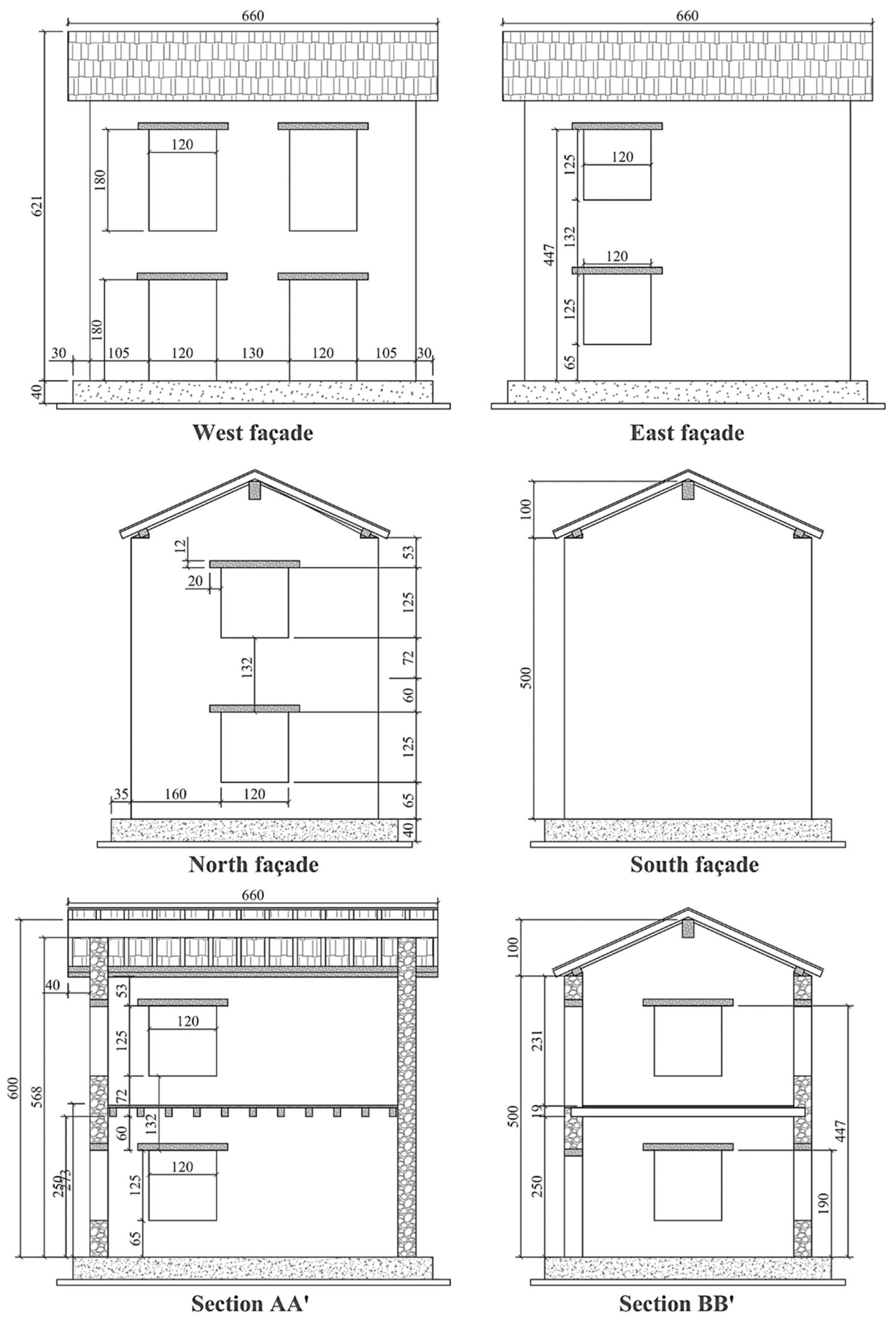
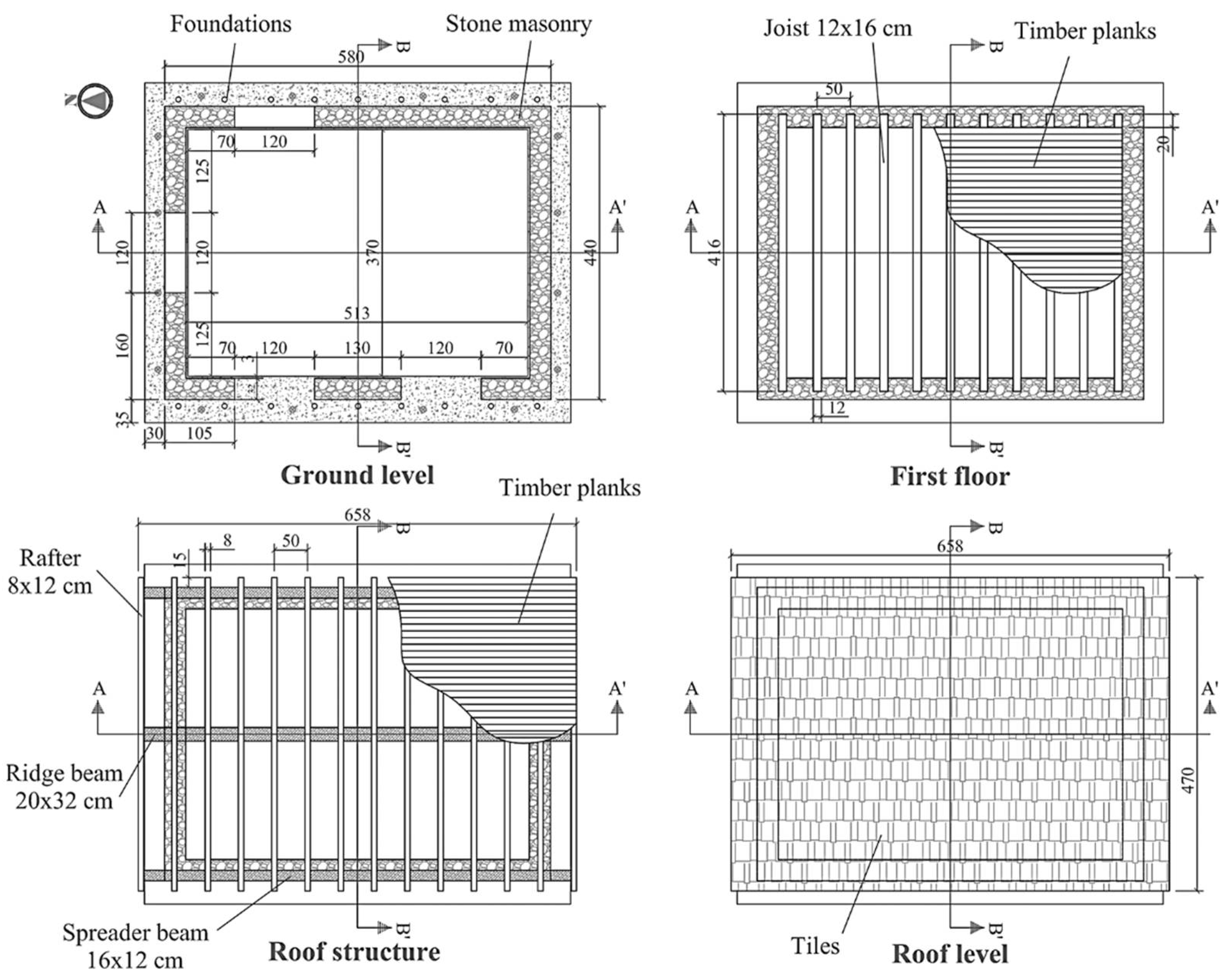
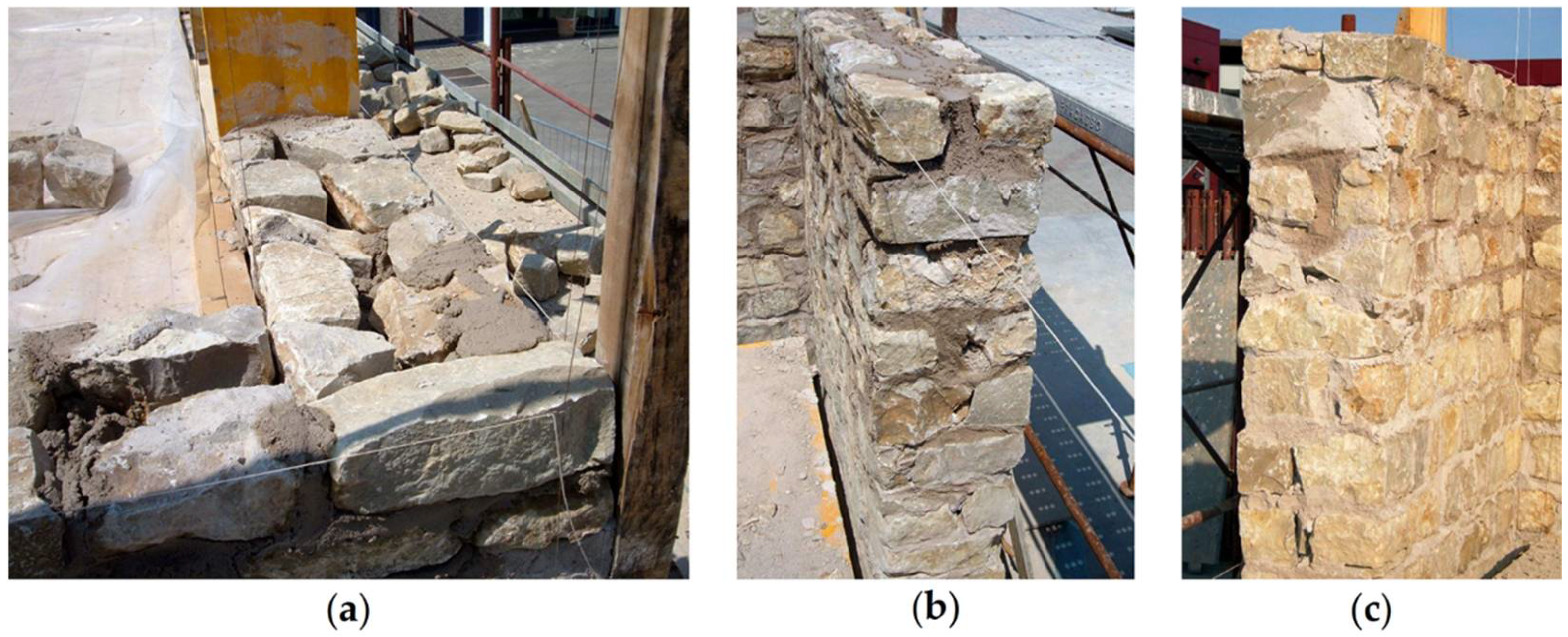
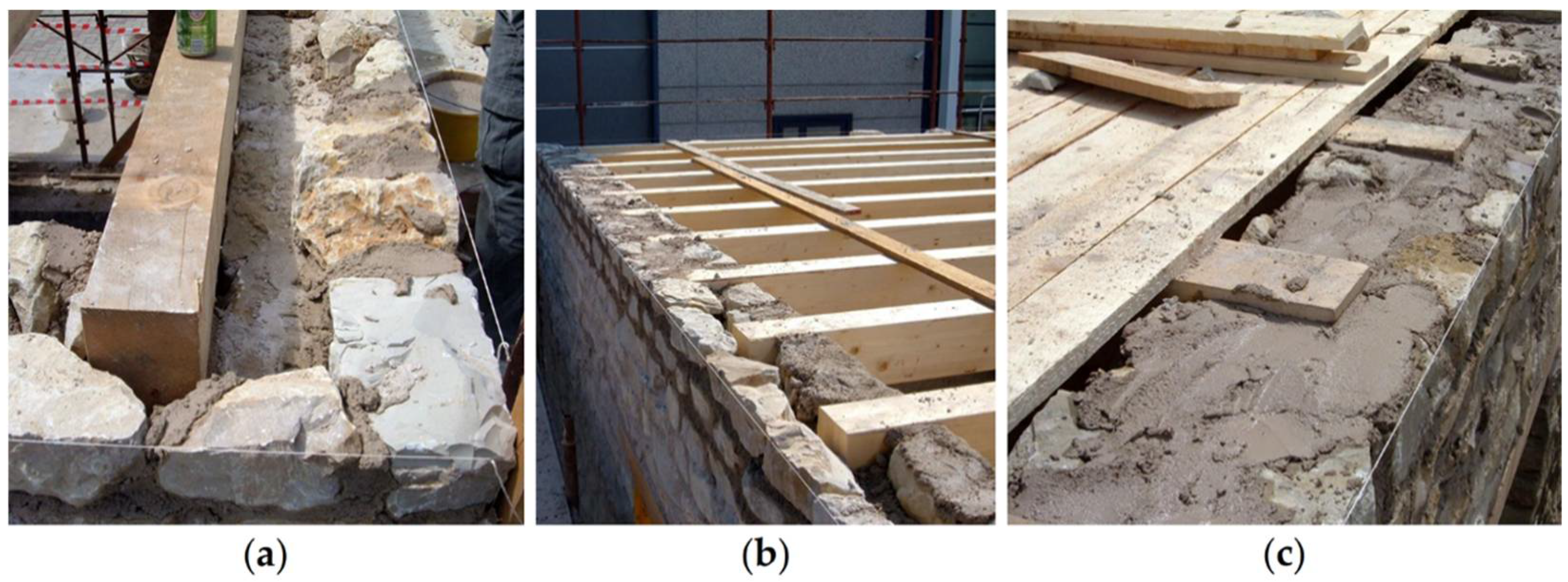
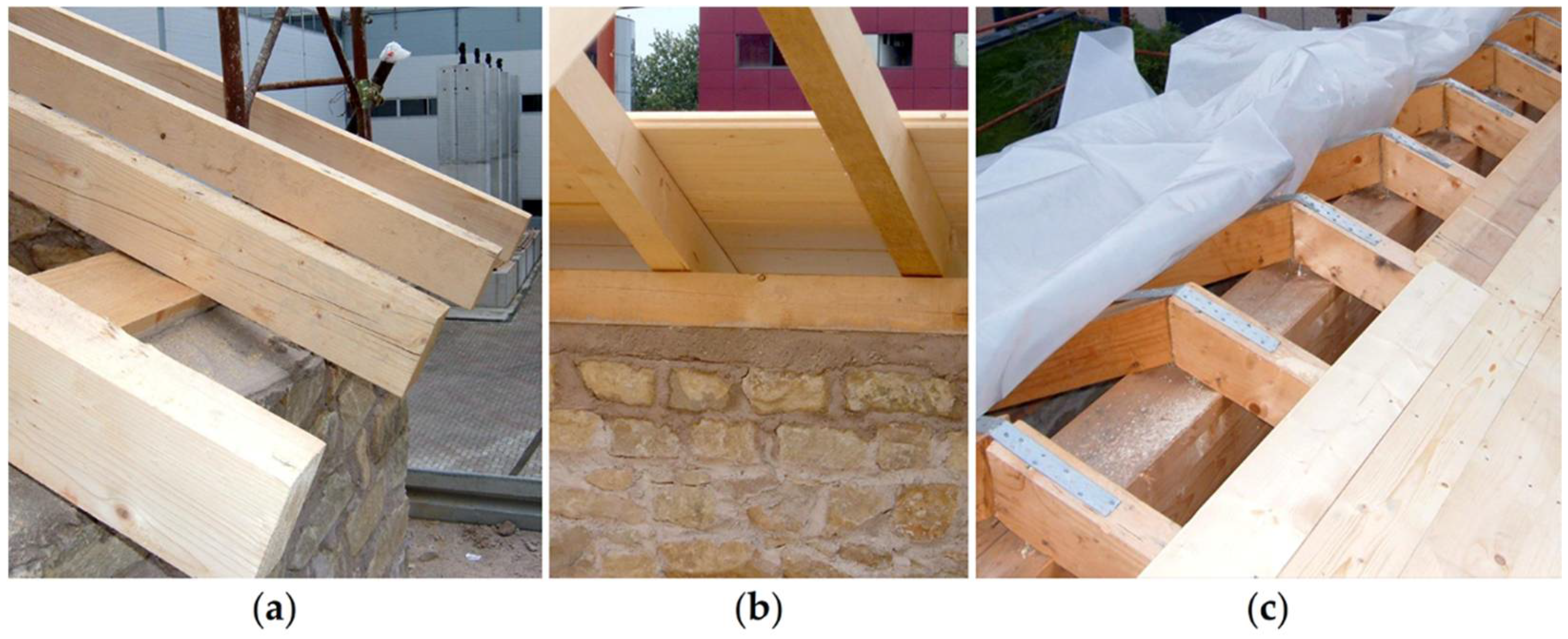
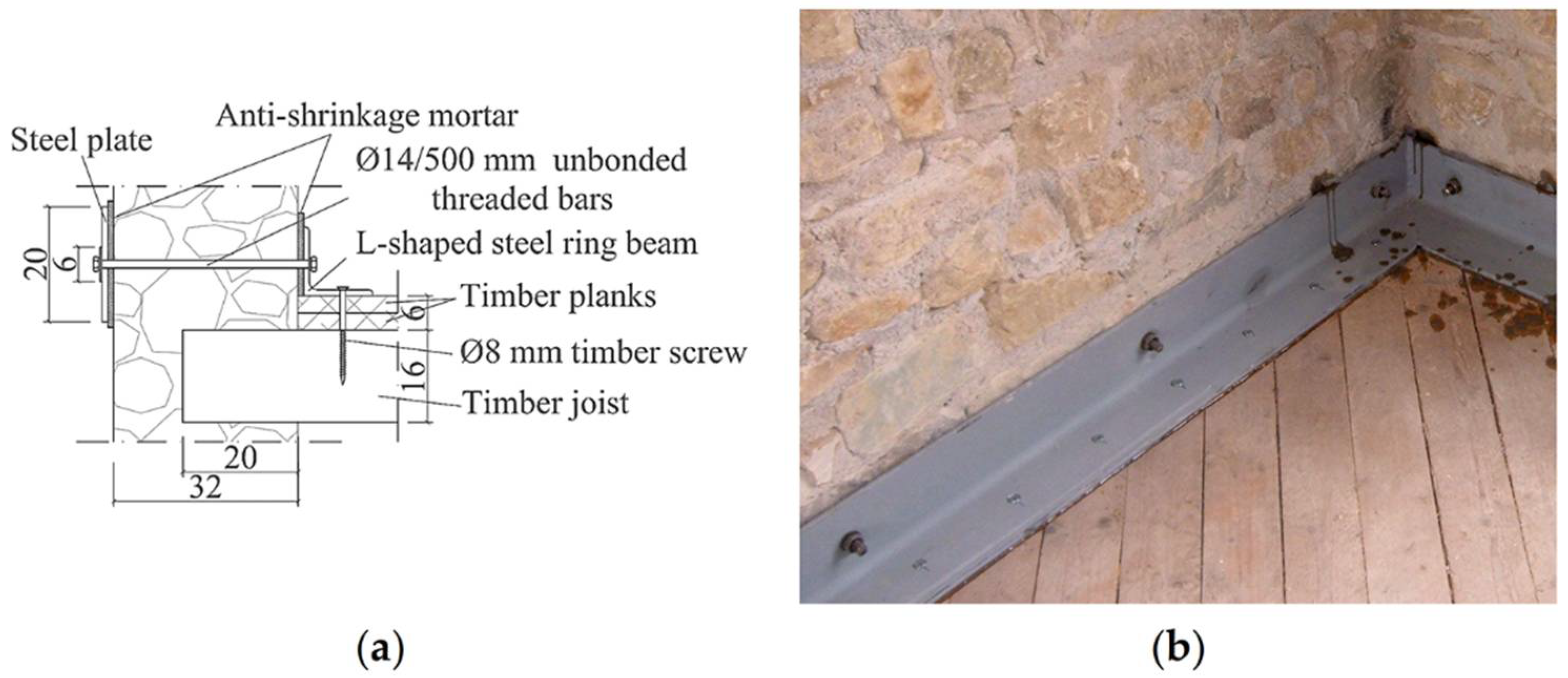
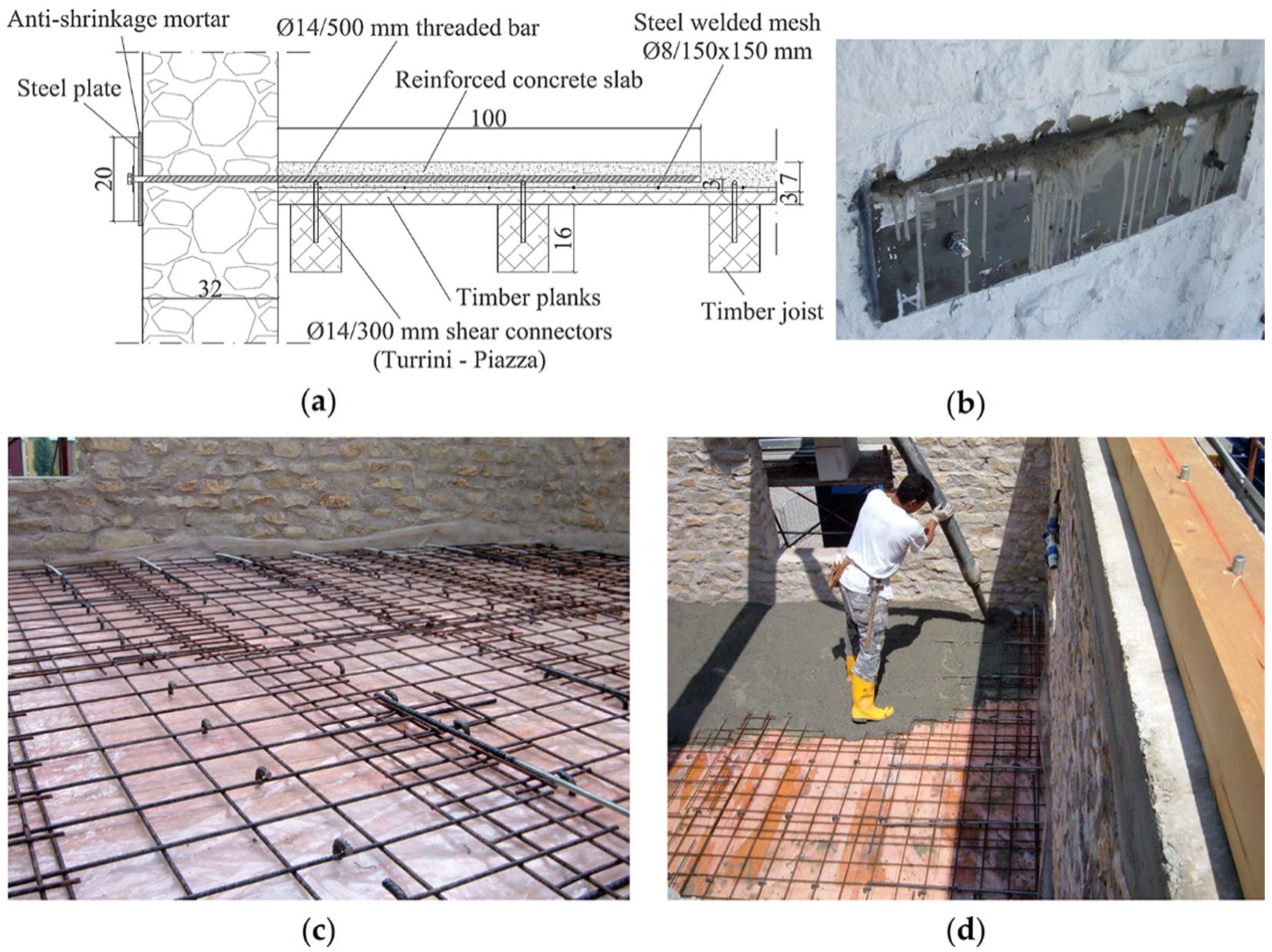
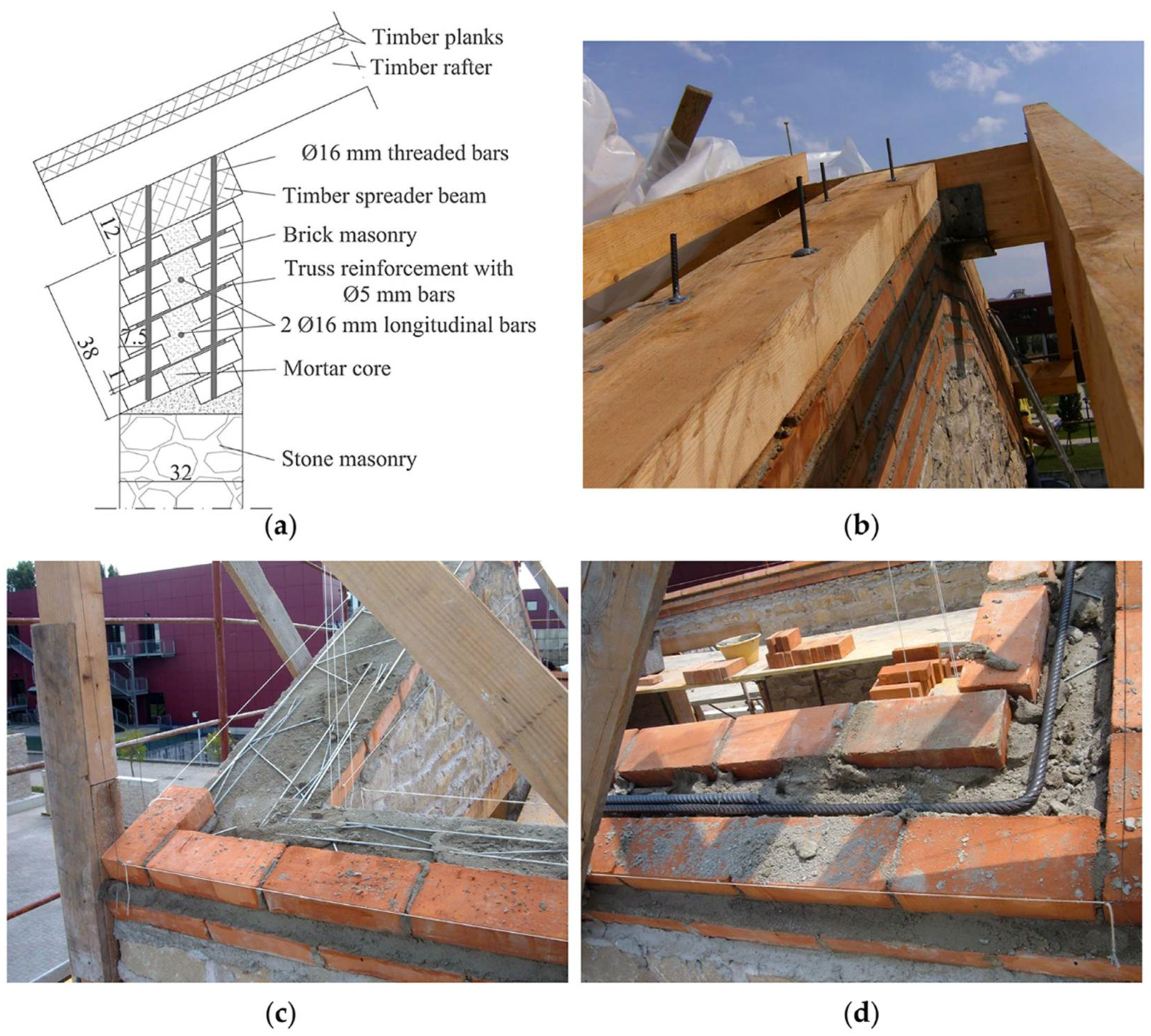
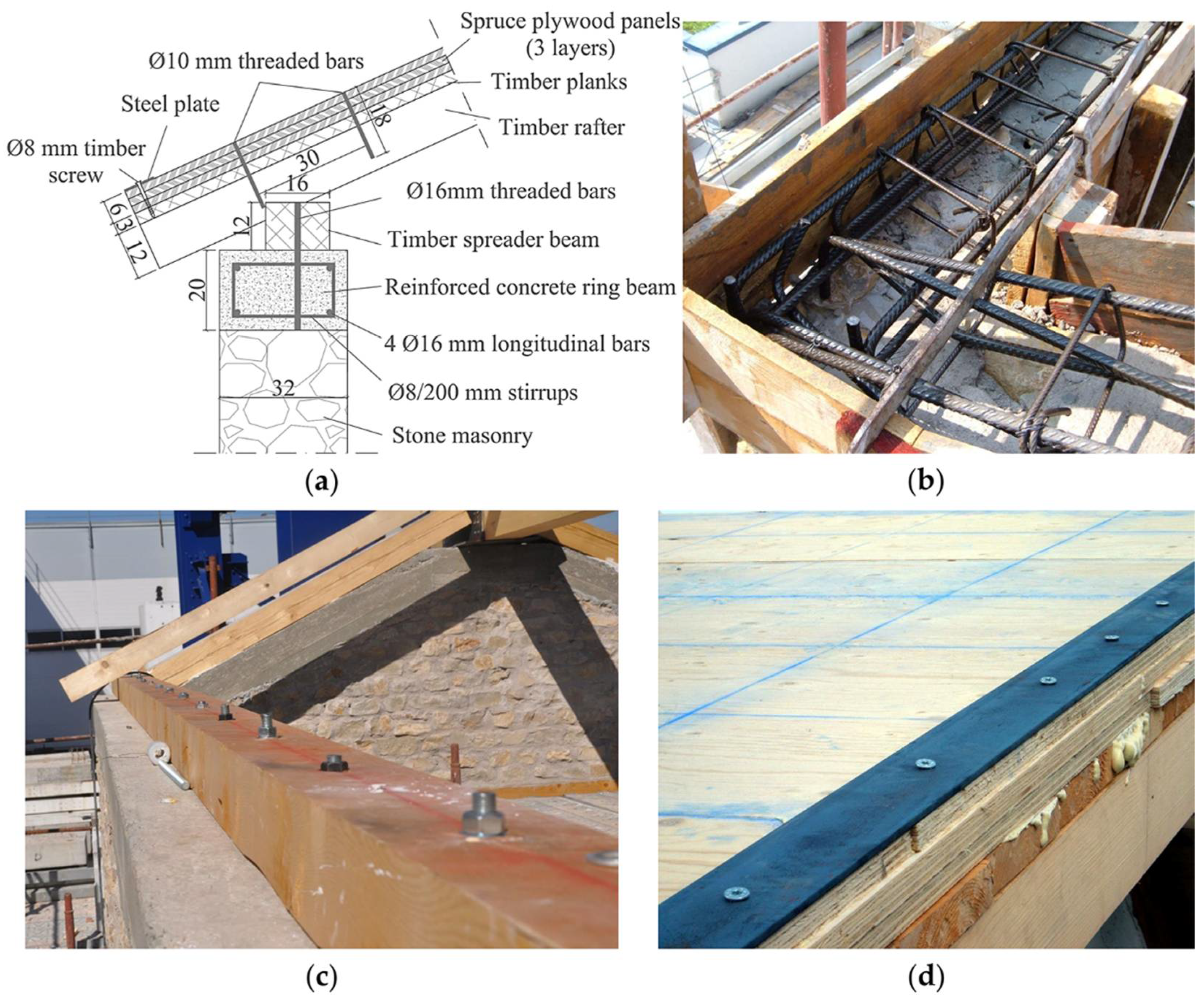
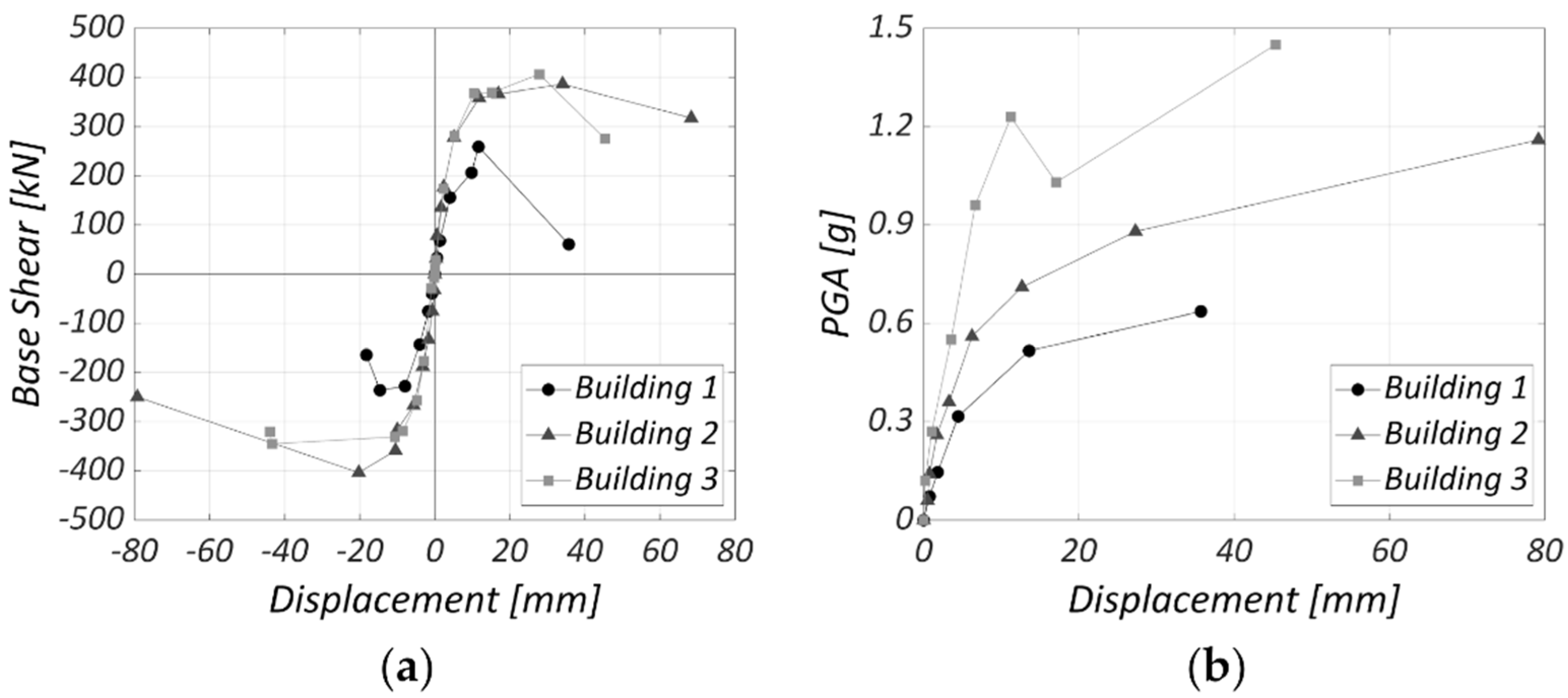

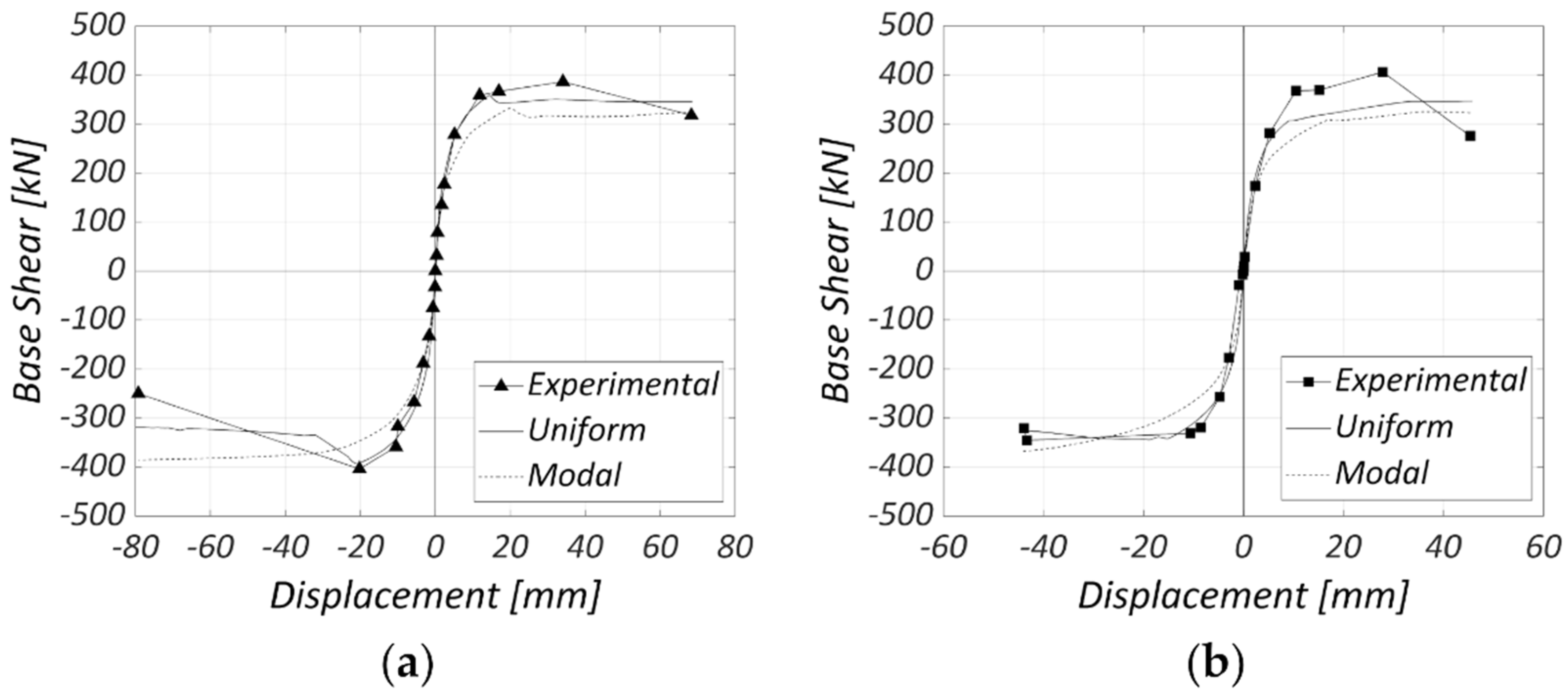
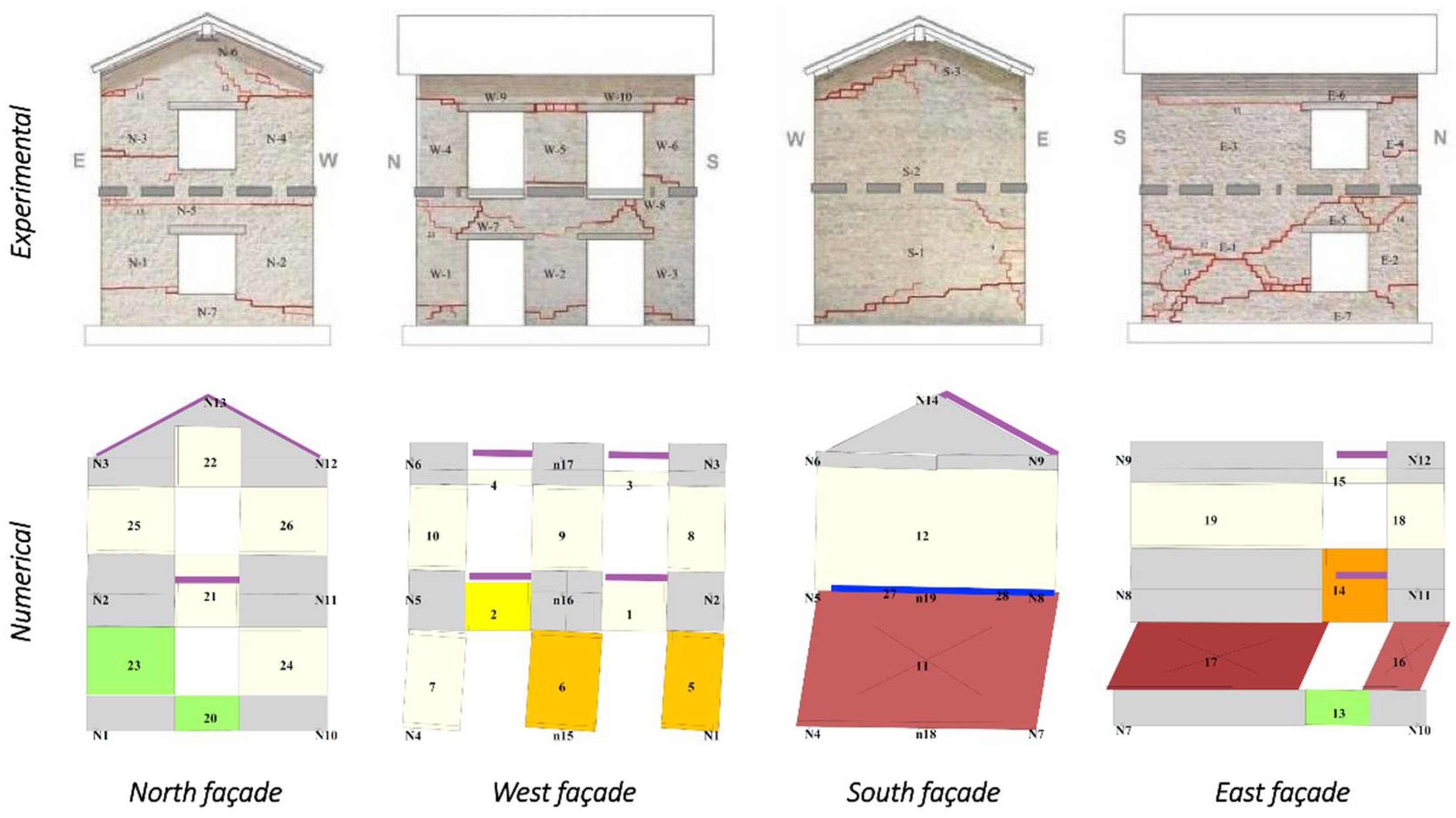
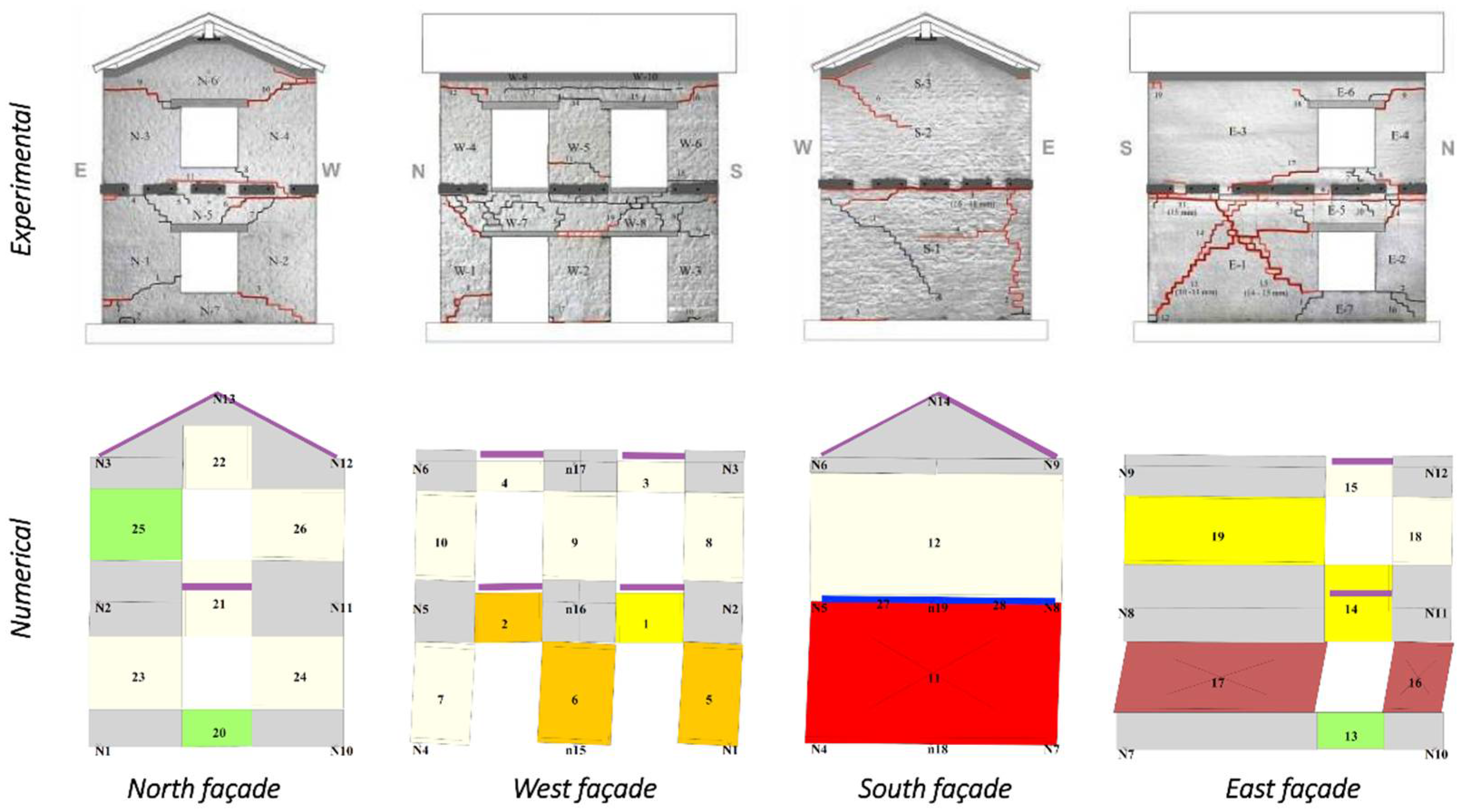
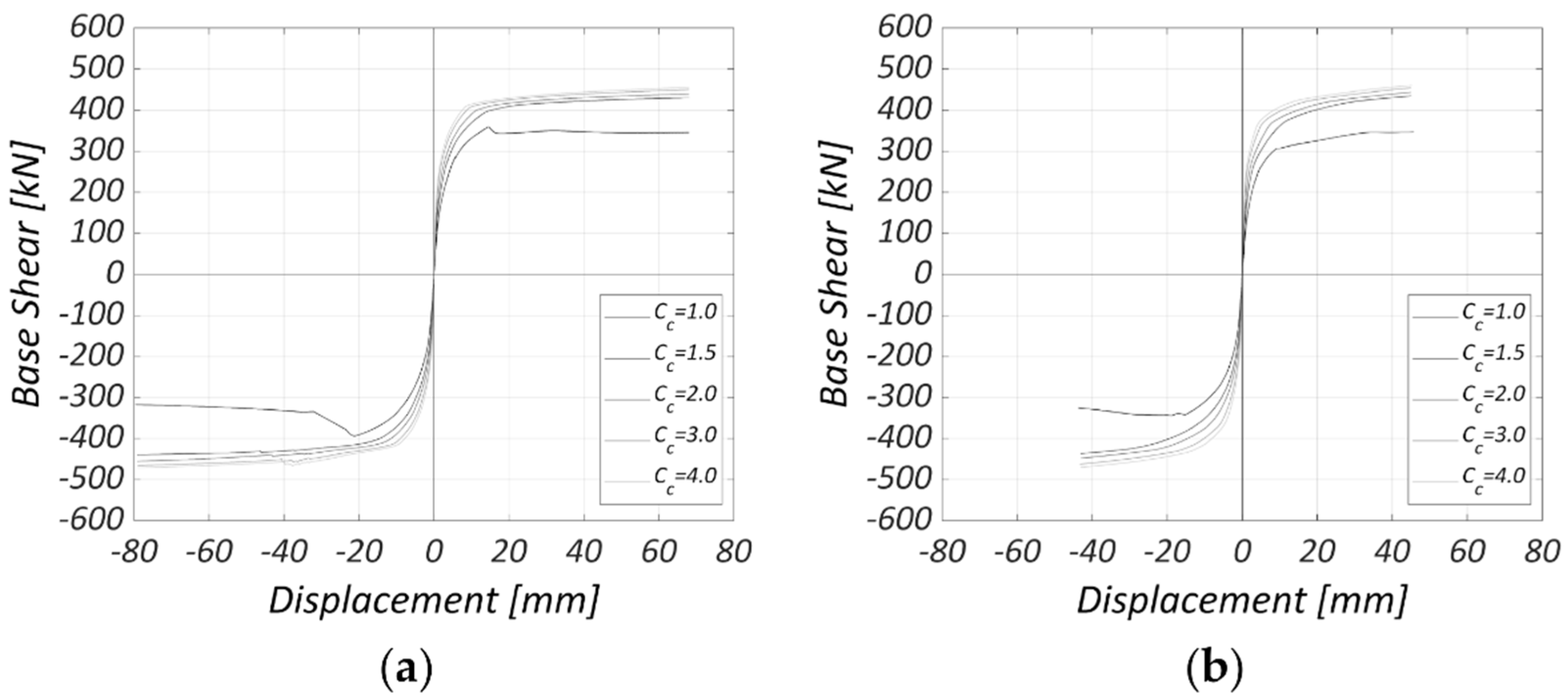
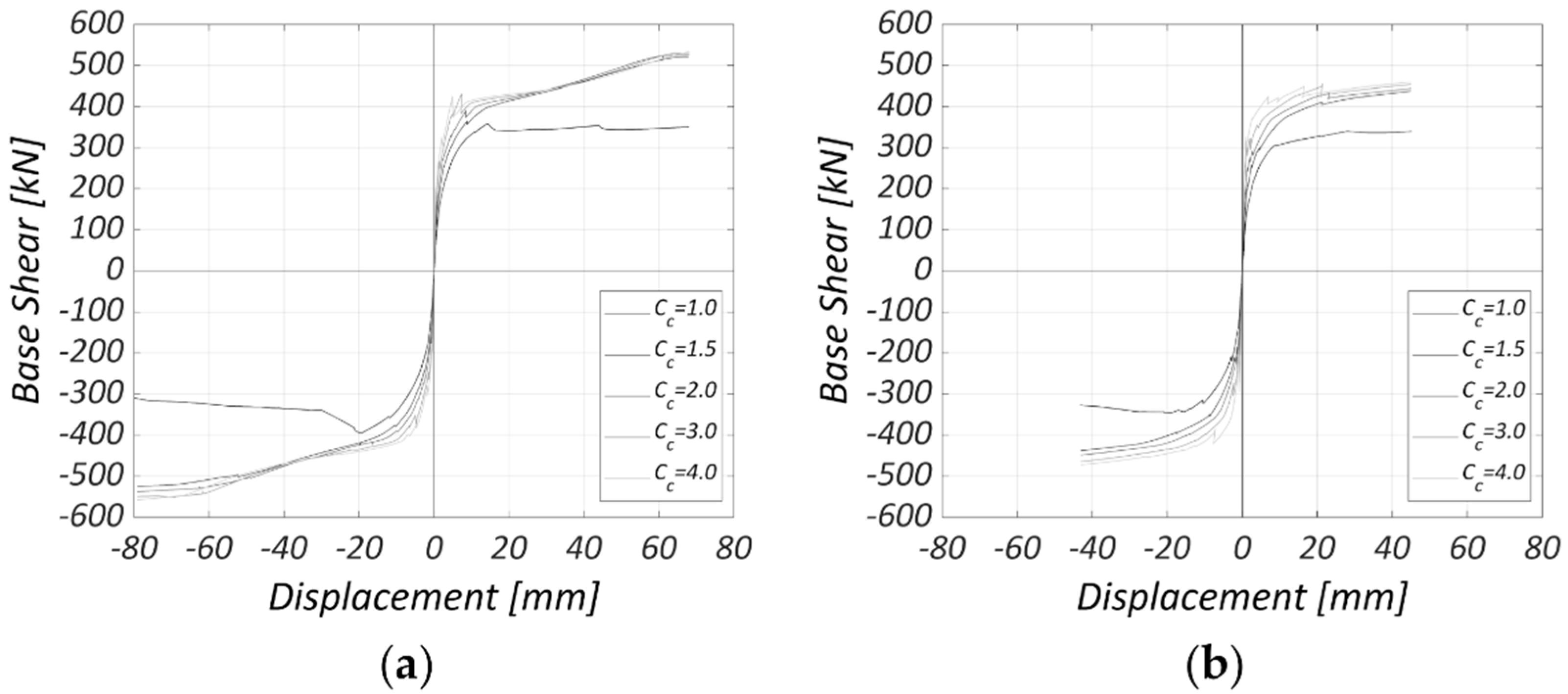

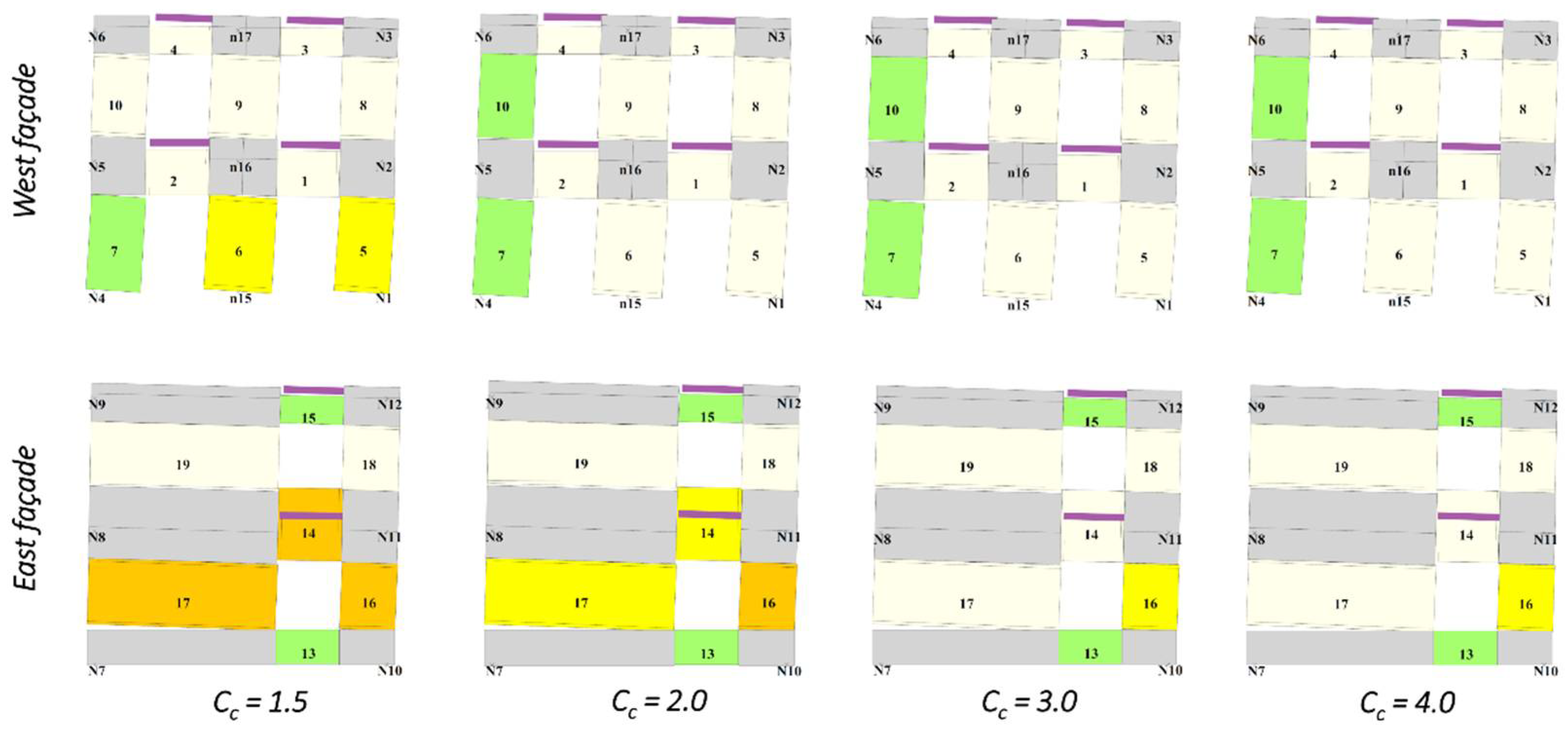
| E (MPa) | G (MPa) | fm (MPa) | ft (MPa) | |
|---|---|---|---|---|
| Mean | 2550 | 840 | 3.28 | 0.137 |
| St. Dev. | 345 | 125 | 0.26 | 0.031 |
| C.o.V | 13.5% | 14.8% | 8.0% | 21.8% |
| Material | ρ (kg/m3) |
|---|---|
| Double-leaf stone masonry | 2250 |
| Normal weight RC | 2500 |
| Lightweight RC | 1500 |
| Steel | 7850 |
| Timber | 600 |
| Test | Building 1 PGA (g) | Building 2 PGA (g) | Building 3 PGA (g) |
|---|---|---|---|
| 1 | 0.07 | 0.06 | 0.12 |
| 2 | 0.14 | 0.14 | 0.27 |
| 3 | 0.31 | 0.26 | 0.55 |
| 4 | 0.50 | 0.36 | 0.92 |
| 5 | 0.63 | 0.56 | 1.28 |
| 6 | 0.70 * | 0.71 | 1.04 |
| 7 | - | 0.88 | 1.49 |
| 8 | - | 1.16 | 0.66 ** |
| Pier | l (mm) | h (mm) | t (mm) | σ0 (MPa) | b (-) | (kN) | (kN) | (MPa) | (MPa) |
|---|---|---|---|---|---|---|---|---|---|
| Slender 1 | 1250 | 2500 | 320 | 0.5 | 1.5 | 86 | 94 | 0.16 | 0.18 |
| Slender 2 | 1250 | 2500 | 320 | 0.2 | 1.5 | 45 | 48 | 0.10 | 0.11 |
| Squat 1 | 2500 | 2500 | 320 | 0.5 | 1 | 234 | 225 | 0.13 | 0.13 |
| Squat 2 | 2500 | 2500 | 320 | 0.2 | 1 | 135 | 154 | 0.10 | 0.12 |
| Model | Element | E (MPa) | G (MPa) | fm (MPa) | μeq (-) | ceq (MPa) | β (-) | Gct (-) |
|---|---|---|---|---|---|---|---|---|
| Building 2 | Slender p. | 2030 | 560 | 3.28 | 0.261 | 0.137 | 0.4 | 10 |
| Squat p. | 2030 | 560 | 3.28 | 0.328 | 0.109 | 0.4 | 10 | |
| Spandrels | 2030 | 560 | 3.28 | 0.261 | 0.137 | 0.0 | 10 | |
| Building 3 | Slender p. | 2030 * | 560 * | 3.28 | 0.253 | 0.138 | 0.4 | 10 |
| Squat p. | 2030 * | 560 * | 3.28 | 0.315 | 0.111 | 0.4 | 10 | |
| Spandrels | 1015 | 280 | 3.28 | 0.253 | 0.138 | 0.0 | 10 |
| Model | Diaphr. | tm (m) | E1 (MPa) | E2 (MPa) | ν (-) | G12 (MPa) |
|---|---|---|---|---|---|---|
| Building 2 | Floor | 0.05 | 11,186 | 9000 | 0 | 12 |
| Roof | 0.05 | 11,186 | 9000 | 0 | 12 | |
| Building 3 | Floor | 0.10 | 13,928 | 13,088 | 0 | 3881 |
| Roof | 0.10 | 8220 | 9300 | 0 | 71 |
| Model | Element | E (MPa) | G (MPa) | A (cm2) | J (cm4) |
|---|---|---|---|---|---|
| Building 2 | Steel ring beam | 206,000 | 78,400 | 23.2 | 313 |
| RM ring beam | 5600 | 1400 | 16 | 310,000 | |
| Building 3 | E-W RC slab | 14,411 | 5543 | 0 | 5370 |
| N-S RC slab | 14,411 | 5543 | 0 | 7370 | |
| RC ring beam | 31,000 | 13,000 | 640 | 21,333 |
Publisher’s Note: MDPI stays neutral with regard to jurisdictional claims in published maps and institutional affiliations. |
© 2021 by the authors. Licensee MDPI, Basel, Switzerland. This article is an open access article distributed under the terms and conditions of the Creative Commons Attribution (CC BY) license (https://creativecommons.org/licenses/by/4.0/).
Share and Cite
Guerrini, G.; Salvatori, C.; Senaldi, I.; Penna, A. Experimental and Numerical Assessment of Seismic Retrofit Solutions for Stone Masonry Buildings. Geosciences 2021, 11, 230. https://doi.org/10.3390/geosciences11060230
Guerrini G, Salvatori C, Senaldi I, Penna A. Experimental and Numerical Assessment of Seismic Retrofit Solutions for Stone Masonry Buildings. Geosciences. 2021; 11(6):230. https://doi.org/10.3390/geosciences11060230
Chicago/Turabian StyleGuerrini, Gabriele, Christian Salvatori, Ilaria Senaldi, and Andrea Penna. 2021. "Experimental and Numerical Assessment of Seismic Retrofit Solutions for Stone Masonry Buildings" Geosciences 11, no. 6: 230. https://doi.org/10.3390/geosciences11060230
APA StyleGuerrini, G., Salvatori, C., Senaldi, I., & Penna, A. (2021). Experimental and Numerical Assessment of Seismic Retrofit Solutions for Stone Masonry Buildings. Geosciences, 11(6), 230. https://doi.org/10.3390/geosciences11060230







